Why pay attention to Infrared?
On one hand, Infrared is currently executing a points program phase, and there will be airdrops in the future.
On the surface, Infrared appears to be part of the LSD (Liquid Staking Derivatives) sector. However, Infrared is distinct from existing LSD projects like Lido.
💠 Proof of POL from Berachain
As a liquidity infrastructure for the Berachain ecosystem, the differentiation designed by Berachain is one of the fundamental reasons why Infrared is different.
🔷 The dual-token model separates security and incentives
◆ Dual-token model: Berachain uses a dual-token model, $BERA + $BGT.
$BERA, like other tokens, supports transfers, trading, etc. However, $BGT is non-transferable and non-tradable.
$BGT is a governance token, and its monetization model is to destroy $BGT at a 1:1 ratio and exchange it for $BERA. However, conversely, $BERA cannot be exchanged for or purchased with $BGT.
◆ Security: The top 69 validators stake $BERA as a security guarantee. Meanwhile, they earn GAS fees ($BERA), ecological shares (various ecological tokens), and fixed block rewards ($BGT) as cost compensation and basic income.
◆ Incentives: Validators and users delegate $BGT to validators to earn Boost rewards. This part of the reward mainly incentivizes validators and users to provide liquidity to Berachain.
◆ Security separation: If a validator encounters problems, part of their staked $BERA may be deducted. However, this will not affect the $BGT delegated by users.
🔷 Liquidity compounding
◆ Ways to obtain $BGT
› Validators receive fixed block rewards while working, with rewards distributed in $BGT.
› Delegate $BGT to validators, and the Boost rewards obtained are distributed in $BGT.
› Add liquidity to the permitted DEX and receive LP tokens. Staking LP tokens can earn $BGT rewards.
◆ Liquidity compounding
First, in the Berachain ecosystem, adding liquidity to the DEX can yield trading fee income from the trading pool.
Secondly, staking the corresponding LP tokens can yield $BGT rewards.
Third, delegating $BGT to validators can yield additional delegated income, including Boost rewards from Berachain blocks, voting rewards from validators, and dividends from ecological Dapps.
This is the liquidity triple compounding of the Berachain ecosystem, which enhances the utilization of funds in the Berachain ecosystem, differing from the coin-to-coin model of POS consensus.
💠 Pol-vaults + $iBGT optimizes user participation process
🔷 Risks and complexities of native POL
◆ Risks faced by users of native POL
In POS mode, users can participate in mining by purchasing and staking public chain coins, bearing only the risks from the price volatility of these coins. Moreover, users can always reduce such risks through buying and selling public chain coins.
In the native POL model, since $BGT cannot be traded or transferred, users must first add LP and then stake LP tokens to earn $BGT. While users gain triple liquidity compounding, they also bear the dual risks of impermanent loss and price volatility of LP assets.
Moreover, users cannot reduce short-term risks through flexible buying and selling of $BGT. They must either give up $BGT, destroy it, and exchange for $BERA, or continue to hold $BGT.
◆ Complexity of user participation in native POL
On the other hand, when users choose validators for delegation, they need to analyze the comprehensive situation of each validator and frequently pay attention to and adjust their delegated targets. For example, if a validator reduces the staked $BERA, it will decrease the probability of that validator earning rewards. Alternatively, delegating too much $BGT to a validator may reduce the Boost rewards that users receive. This brings complexity and timeliness challenges for users.
🔷 Pol-vaults + $iBGT optimize the user participation process
◆ More flexible separation of processes into two phases
Infrared has keenly identified these pain points for users and launched the Pol-vaults + $iBGT model.
Users deposit LP tokens into Infrared's Pol-vaults, and the Infrared protocol deposits the LP tokens into Berachain's native POL. After obtaining $BGT, it issues corresponding $iBGT, and the returns users receive in Infrared's Pol-vaults are not $BGT but $iBGT.
Compared to the non-tradable and non-transferable $BGT, $iBGT has strong flexibility, being tradable on DEX and transferable between wallets.
Users can separate the two stages of participating in LP and delegating to validators. In the first stage, users can deposit LP tokens to earn $iBGT.
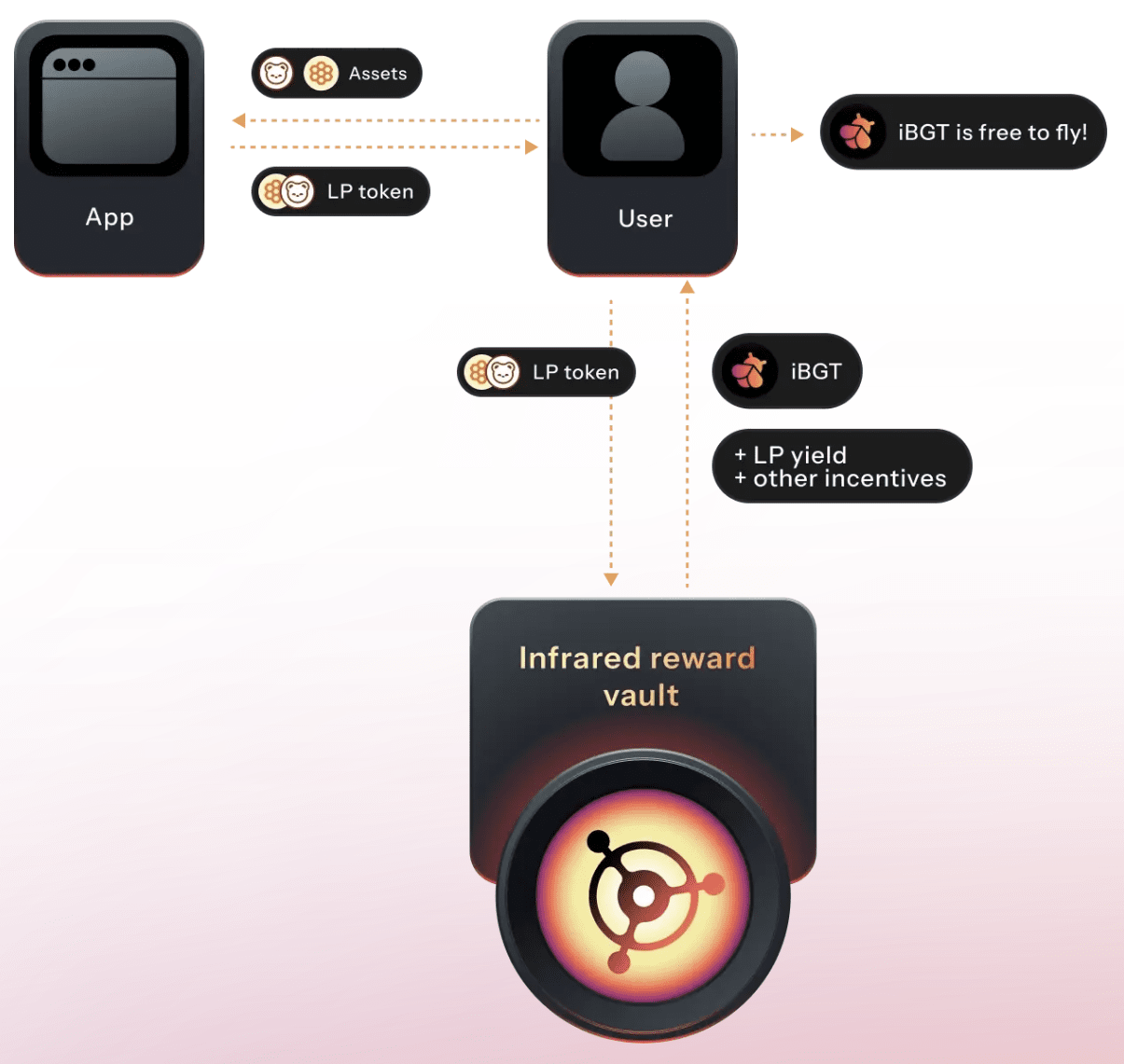
In the second phase, users stake $iBGT to earn Boost delegated income from $BGT.
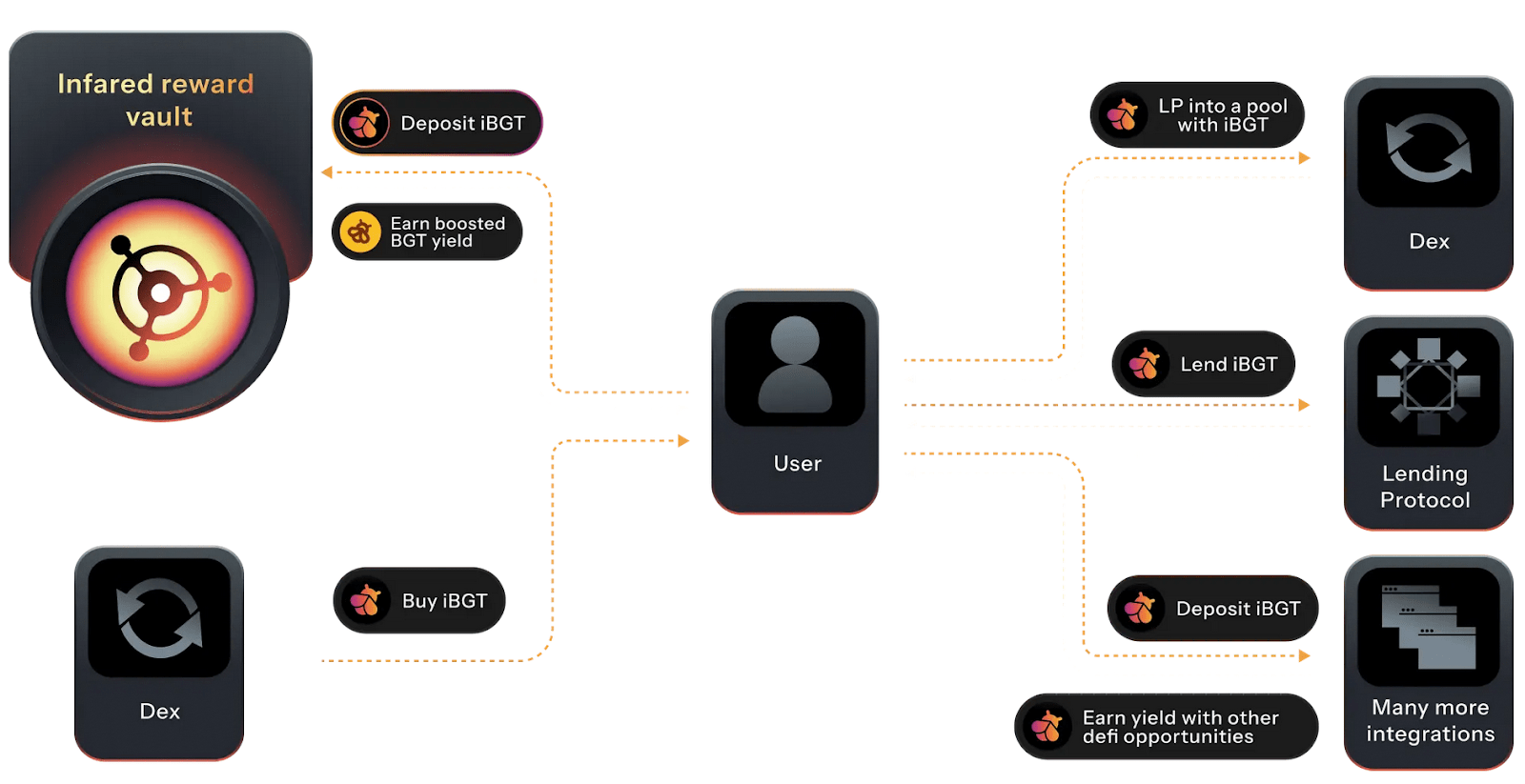
Users can choose:
› Only participate in the first phase. For example, when bearish, use WBTC + WETH to add LP and mine $iBGT to sell.
› Only participate in the second phase. For example, when bullish, directly buy or borrow $iBGT and stake it. (LP of equal value may earn $iBGT more slowly through the first phase.)
› Of course, you can also participate continuously in the first and second phases.
In summary, the separation of the two phases provides users with ample flexibility, allowing for better formulation of yield and risk strategies.
◆ Liquidity delegation agent service
The source of income from users staking $iBGT comes from the underlying $BGT delegated to validators, generating delegated income.
In native POL, users must personally choose validators for delegation. However, when staking $iBGT, the Infrared protocol selects validators and executes the delegation.
The Infrared protocol can monitor the status and data of Berachain validators in real-time, allowing $BGT to be delegated to the most suitable validators.
Essentially providing users with liquidity delegation agent services. On one hand, it greatly simplifies the user participation process. On the other hand, it maximizes users' delegated income.
🔷 Ecological data
◆ Pol-vaults data
Currently, the total TVL of Pol-vaults is close to 400 million USD, with the highest APR exceeding 500%.
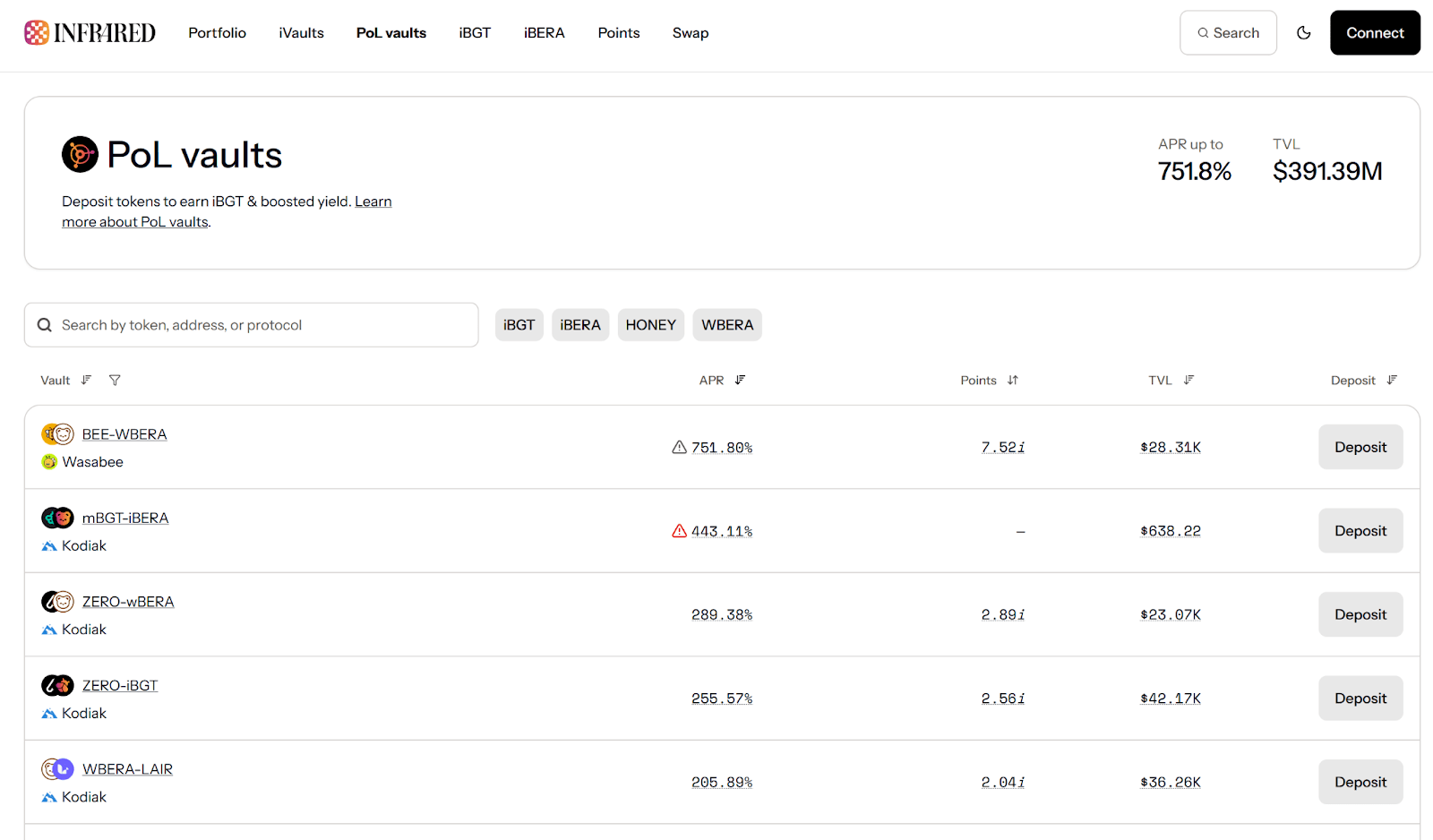
The highest TVL is the cross-chain satSolvBTC to Berachain, with a TVL exceeding 80 million USD. It can be seen that Infrared's Pol-vaults also support non-LP single-asset liquidity.
Moreover, liquidity for non-Berachain native assets is also supported. For example, the LP of the WBTC-WETH trading pair has a TVL exceeding 7 million USD with an annualized yield of 30%.
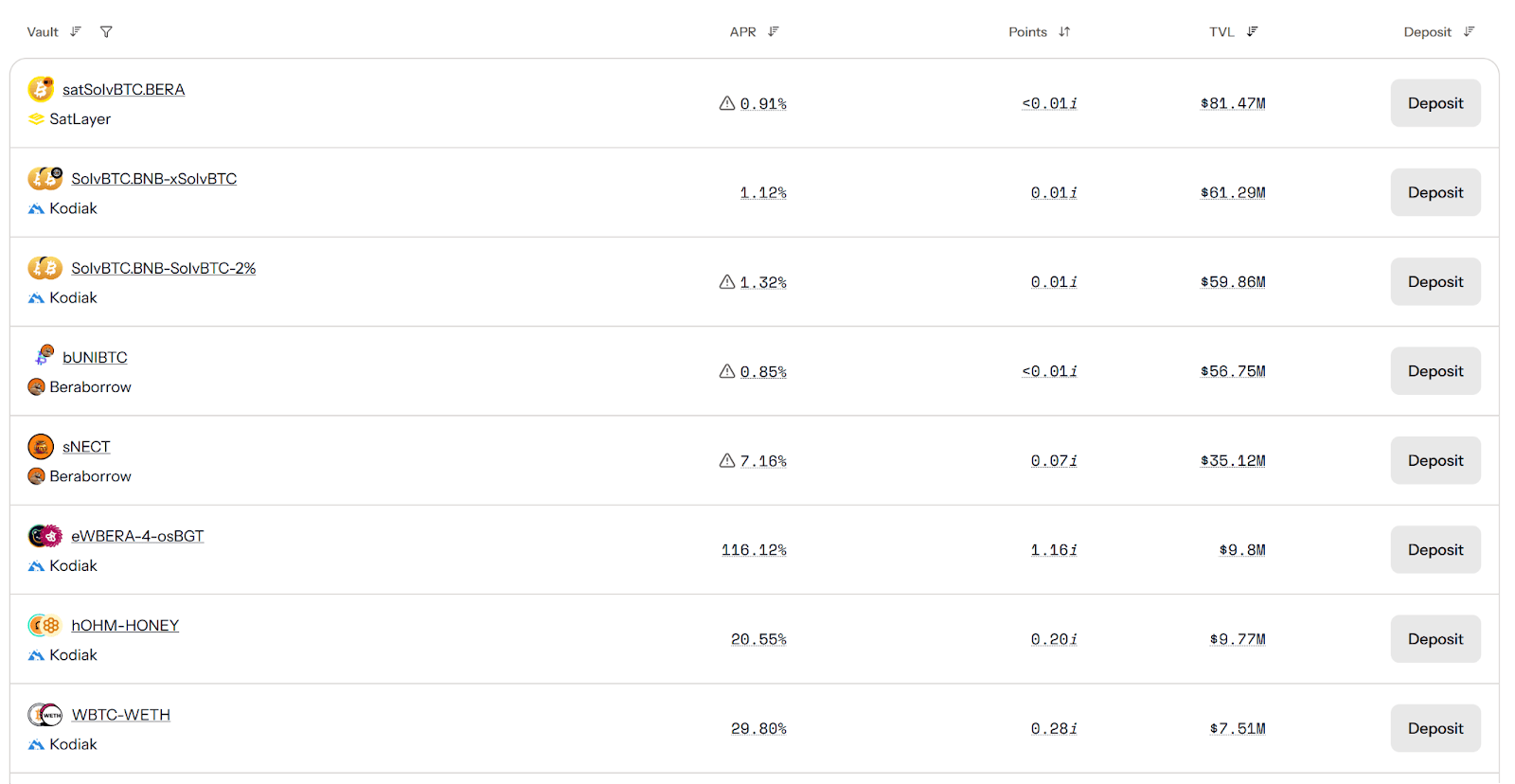
◆ $iBGT data
Since its launch six months ago, the TVL of iBG has basically ranged between 15 million to 30 million USD, currently at 22.94 million USD, with an ARP of 79.36%.
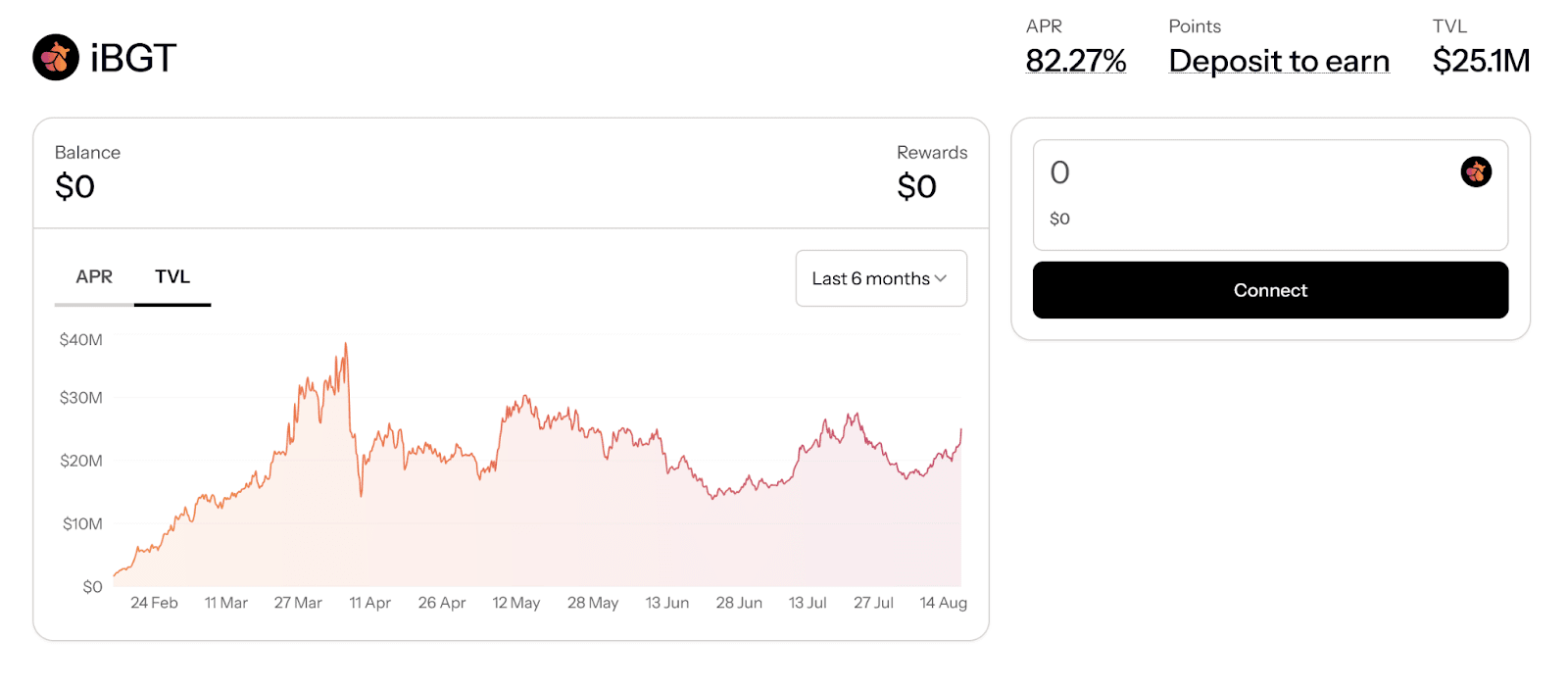
💠 iBERA participates in the role of validators
🔷 Automatic compounding of staking rewards
Users staking $BERA in Infrared can earn $iBERA. Infrared uses these $BERA as validator stakes and distributes the validator income obtained to $iBERA holders.
$iBERA holders effectively participate indirectly in the role of validators in Berachain. Users can earn validator income, including miner fees and additional incentives, and may even include MEV income.
$iBERA's staking rewards are automatically compounded, and users do not need to operate manually; the staking rewards will continue to be staked automatically. Therefore, the income of $iBERA is reflected through the appreciation of $iBERA / $BERA.
iBERA is the product most similar to Lido. (The difference is that Lido can increase validator nodes infinitely as ETH staking increases, while the number of validator nodes that can earn returns for iBERA is capped at 69.)
🔷 iBERA ecological data
In the second half of 2025, the TVL of iBERA stabilizes, currently at 174 million USD, with an APR of 3.24%.
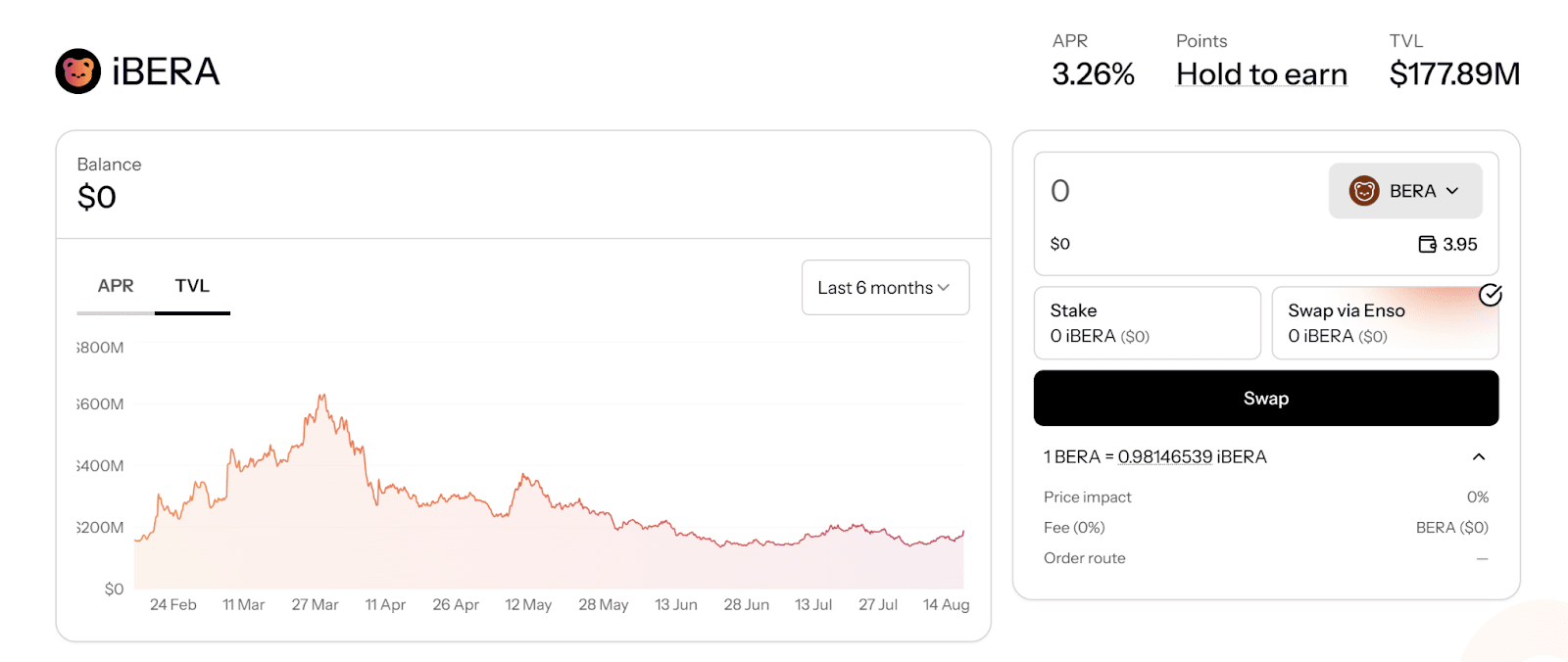
💠 iVault advanced strategies
In late July, Infrared launched the iVault advanced strategy product.
The first product of iVault is BYUSD, where depositing the LP of the BYUSD-HONEY trading pair can yield $iBGT and more. Possible sources of income include Berachain’s POL, BEX, and additional incentives.
BYUSD was launched less than a month ago, and its current TVL has reached 14.6 million USD, with an ARP of 15.02%.
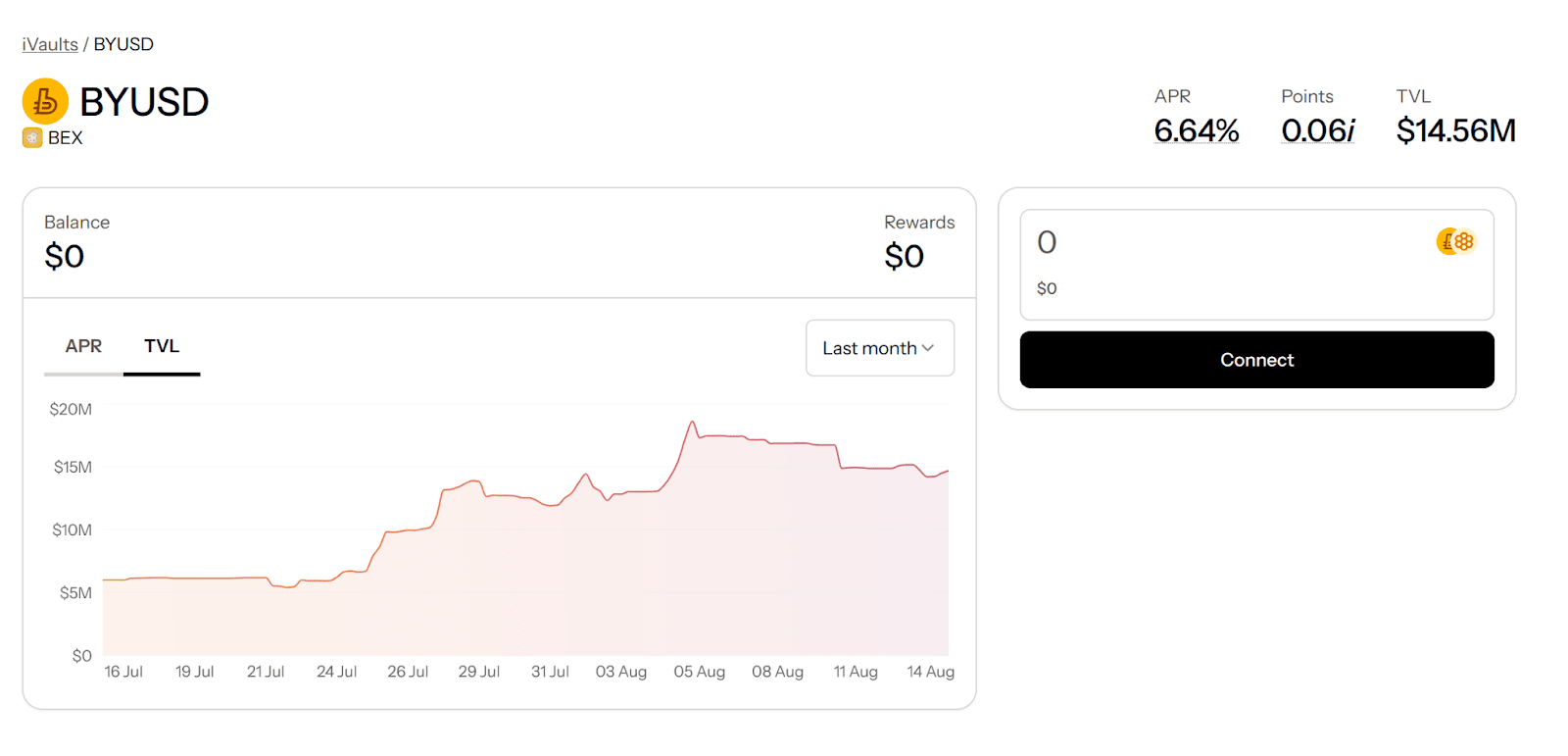
💠 More products from Infrared
🔷 Aimed at developers
Besides the products aimed at ordinary users, Infrared also offers many products for developers, such as various API tools.
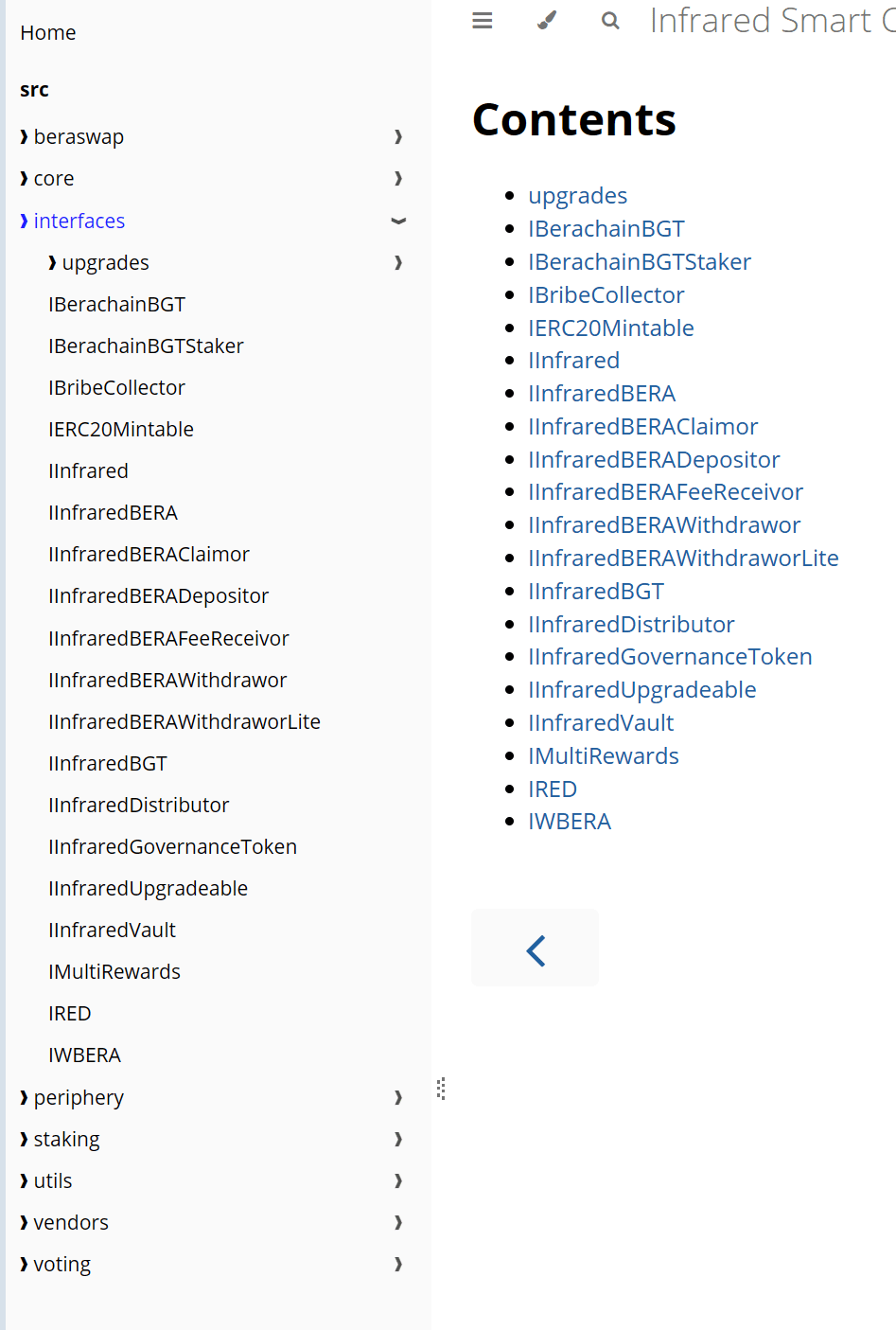
Additionally, Infrared provides extra incentives for validators to guide their behavior (provided it does not harm the Berachain ecosystem).
Infrared also provides automated robotic tools for collecting and staking $iBGT. This allows developers to collect and stake $iBGT more promptly, thereby increasing returns.
🔷 New version in iteration
At the end of July, Infrared released the introduction to version 1.7, marking the seventh upgrade of Infrared, which includes four major updates:
First, the iBGT auction system. The $BGT rewards for staking $iBGT will no longer be directly converted to $wBERA at a 1:1 ratio, but will instead be minted as $iBGT and auctioned for $wBERA. This is to maintain the price of $iBGT/$BERA in accordance with market supply and demand.
Secondly, the reward form of iBERA has been updated. iBERA will still automatically compound, but when the $iBERA/$BERA premium reaches 1.2 or higher, the rewards will remain as $iBGT and will no longer be converted into $BERA for reinvestment.
Third, the dynamic minting fee of $iBGT. When minting $iBGT based on $BGT, a dynamic minting price will be used. When the $iBGT/$BGT price is high, a higher minting fee will be applied; when the price is low, a lower minting fee will be used, thus balancing the price of $iBGT/$BGT.
Fourth, temporarily restrict the redemption of $iBGT. When the price of $iBGT/$BGT falls below 1.0, temporarily restrict the redemption of $iBGT to stabilize the price of $iBGT/$BGT.
The main motive for this update is to strengthen the price balance of $iBGT/$BGT and $iBGT/$BERA, ensuring that it aligns with market supply and demand without causing excessive volatility.
💠 Security
As a financial protocol, security is always a top priority.
🔷 Open source
Firstly, Infrared's code is open source, with the latest update occurring 4 hours ago and 12 hours ago...
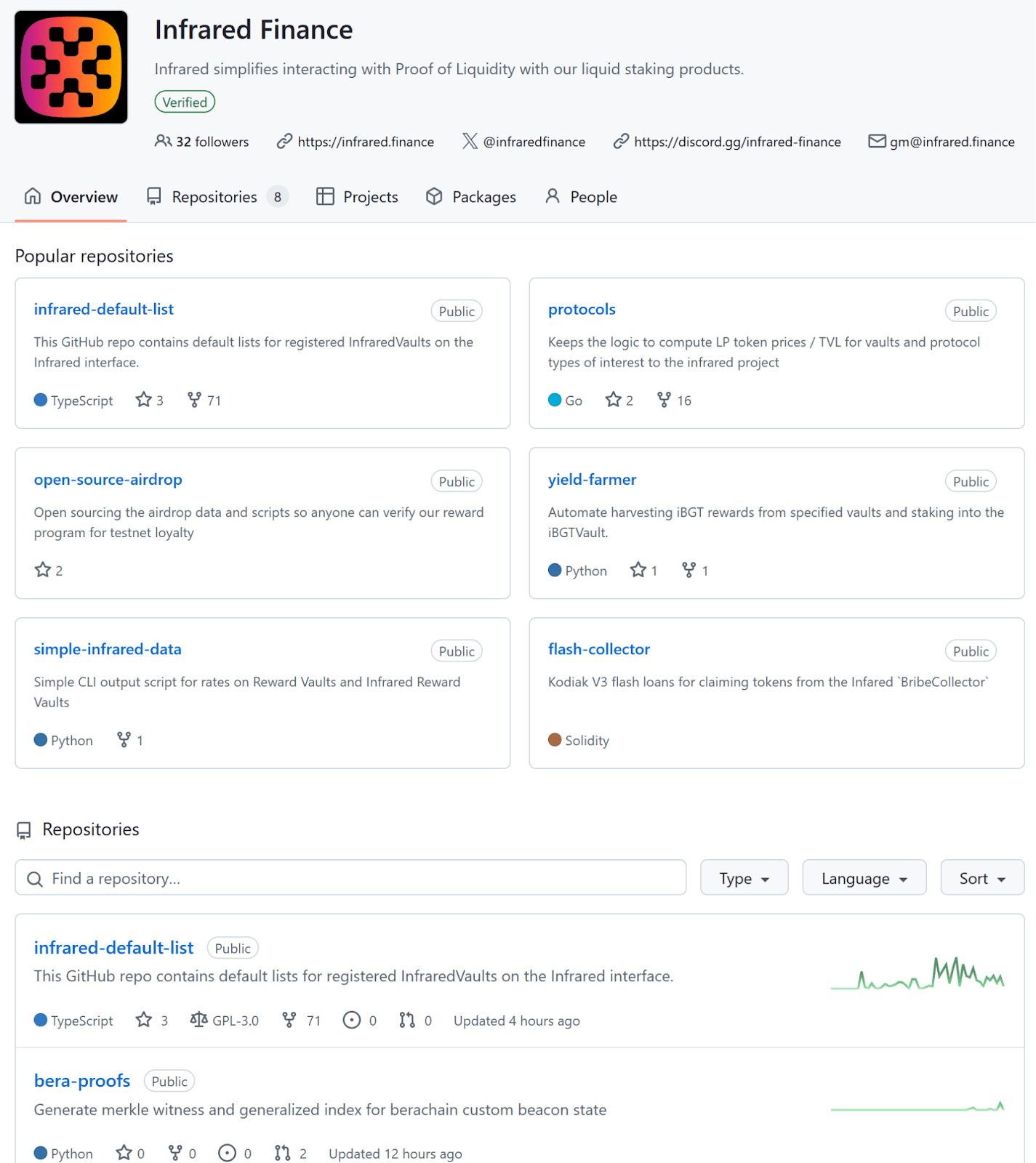
🔷 Code security audit
Secondly, from April 2024 to the present, Zellic, Zenith, Cantina, and Spearbit have conducted 12 security reviews on Infrared, including code audits, security assessments, and security competitions.
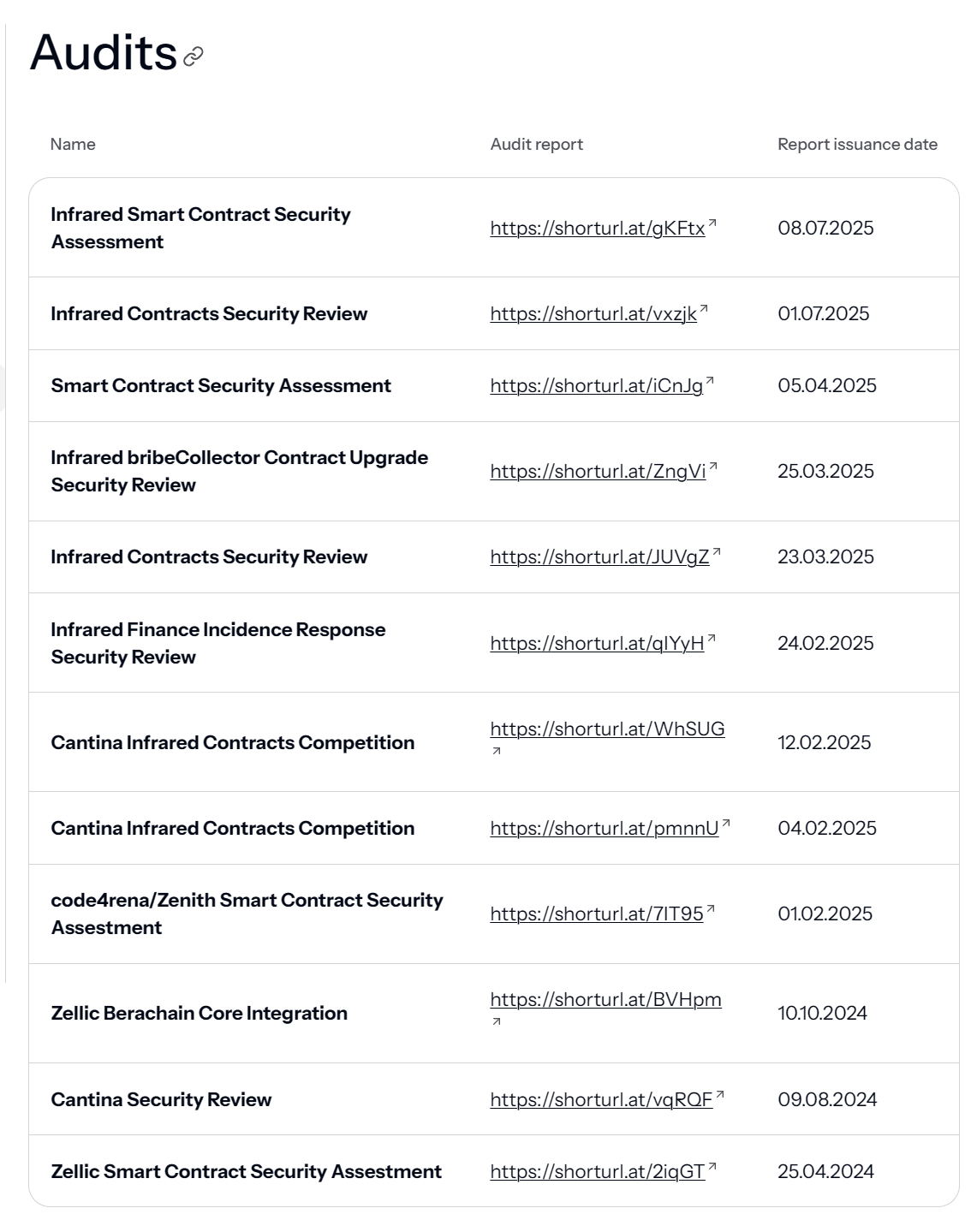
The last two audit reports were released in July 2025, with the auditing agencies being Cantina and Zenith.
The audit report on July 1 found 0 fatal risks, 1 high risk (all resolved), 4 moderate risks (all resolved), 5 low risks (3 resolved), and 15 informational risks (4 resolved).
The Infrared audit report on July 8 found 0 fatal risks, 0 high risks, 2 moderate risks (all resolved), 9 low risks (8 resolved), and 4 informational risks (2 resolved).
💠 The relationship between Infrared and Berachain
Infrared and Berachain have a close collaborative relationship, but they belong to two different teams.
First of all, these two projects complement each other.
🔷 Breachain provides a foundation for Infrared's innovation
The innovation of Berachain's POL consensus provides an innovative foundation for Infrared. iBera is a liquidity product similar to Lido. However, POL Vault + $iBGT is an innovation generated based on POL consensus.
🔷 Infrared enhances the liquidity of the Breachain ecosystem
First, Infrared issues $iBGT based on $BGT, and $iBGT is tradable and transferable, thus injecting vitality into the Breachain ecosystem's liquidity.
Secondly, Infrared has not issued tokens yet and is in the points program phase, which can attract more funds to participate in the ecosystem, thereby increasing liquidity for Berachain.
Thirdly, Infrared has designed more liquidity products based on Berachain, adding more gameplay to the Berachain ecosystem.
🔷 Infrared is becoming the monopolist of Breachain liquidity
According to Berahub, the validators with the highest number of Boosts are mostly occupied by Infrared’s nodes.
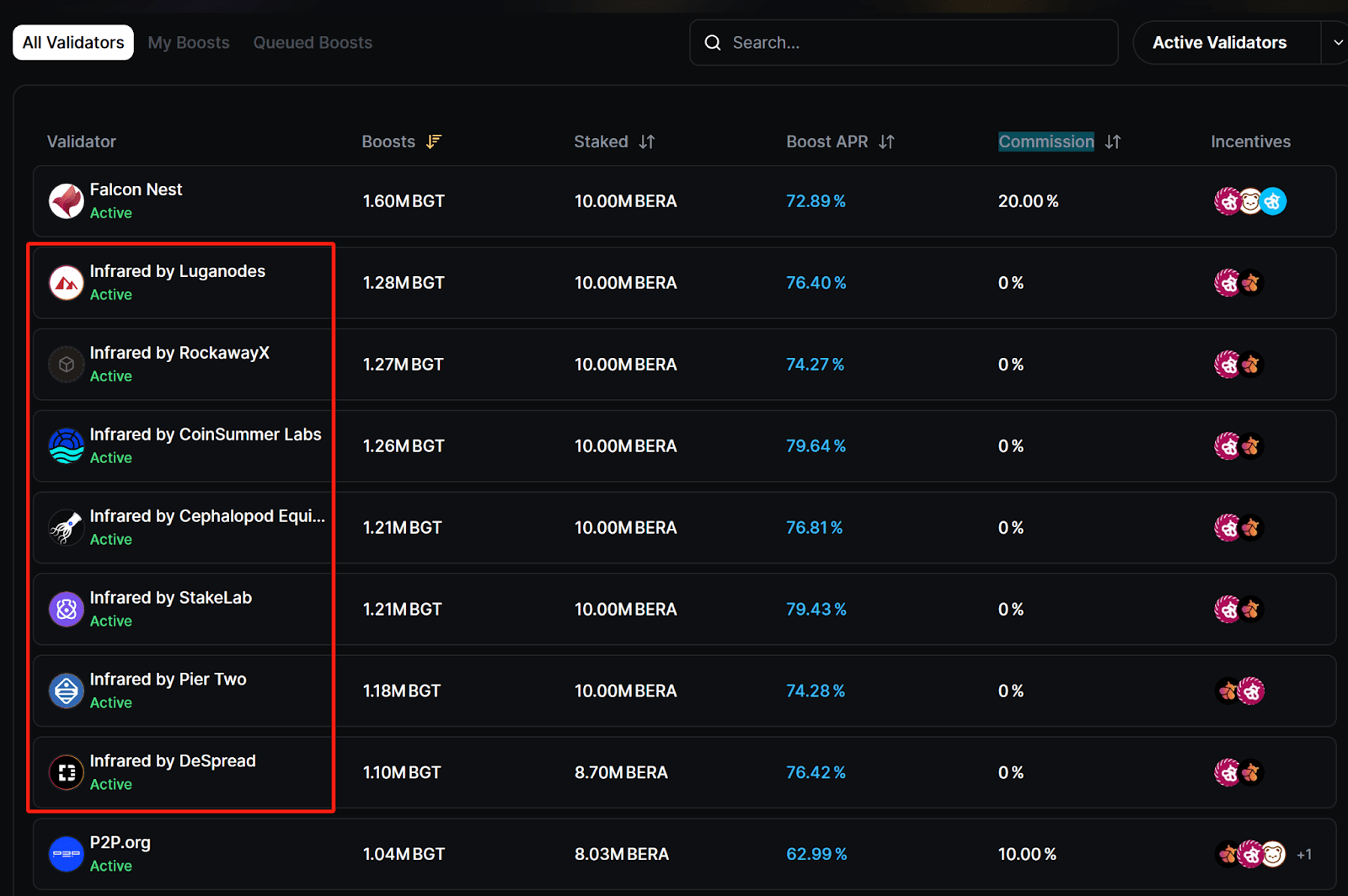
According to Infrared's official website, the total TVL of the platform has reached 533 million USD. Defillama uses different metrics to calculate, with Infrared's TVL at 334 million USD, while the total TVL of the Berachain ecosystem is 383 million USD using the same metrics.
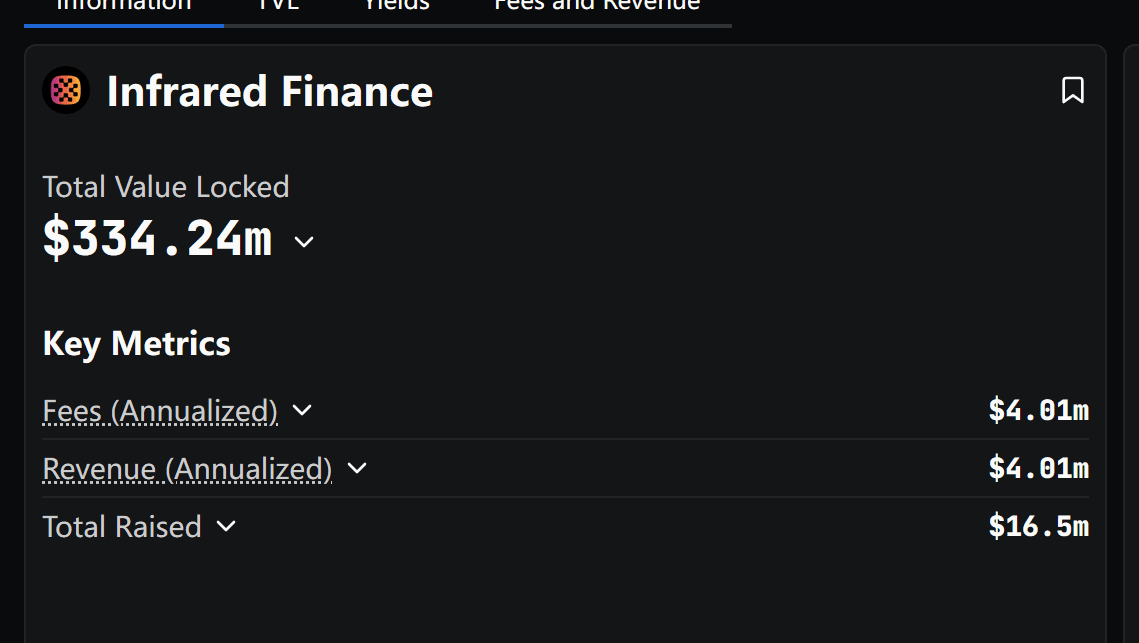
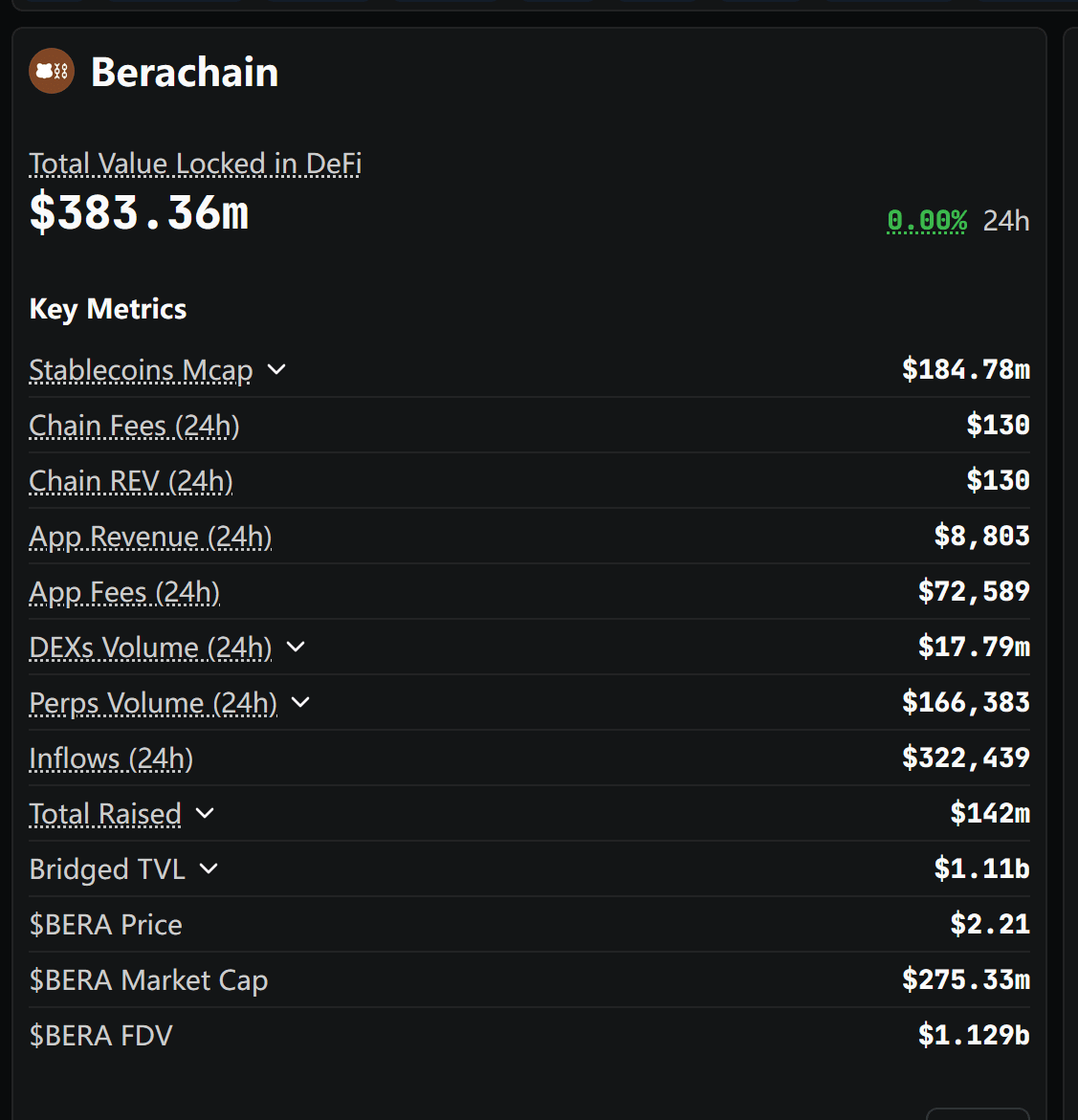
This set of data indicates that Infrared provides almost all liquidity for Berachain.
In contrast, Lido occupies 40.74% of Ethereum liquidity, Kamino occupies 24.45% of Solana liquidity, and pancake occupies 26.51% of BSC liquidity... Echo may occupy slightly more Aptos liquidity, at only 34.89%.
Infrared holds a near-monopoly position in the liquidity of the Berachain ecosystem.
Especially the application of $iBGT, where the underlying corresponding $BGT actually resides within the Infrared protocol. Users trading $iBGT in Swap do not immediately affect the destruction of $BGT. When a large number of users sell $iBGT, Infrared may then destroy $BGT. Thus, Infrared becomes an important factor that influences the supply of $BGT.
According to Berascan, the total supply of $BGT is 19,930,102, while the total supply of $iBGT is 14,451,374, accounting for 72.51% of the total $BGT supply.
To some extent, Infrared has almost become the central bank of $BGT.
💠 The possibility of Infrared stepping out of Berachain
There may be a subtle relationship between Berachain and Infrared. This subtle relationship could give Infrared potential future competitiveness.
Such competitiveness will drive Infrared to develop beyond the Berachain ecosystem.
In fact, both Infrared and Berachain's lead investors include Framework. However, Infrared's lead investors also include Binance (YZi) and Synergis. The investors outside of the lead investors are also different. This means that Infrared might gain resources and support outside of the Berachain ecosystem.
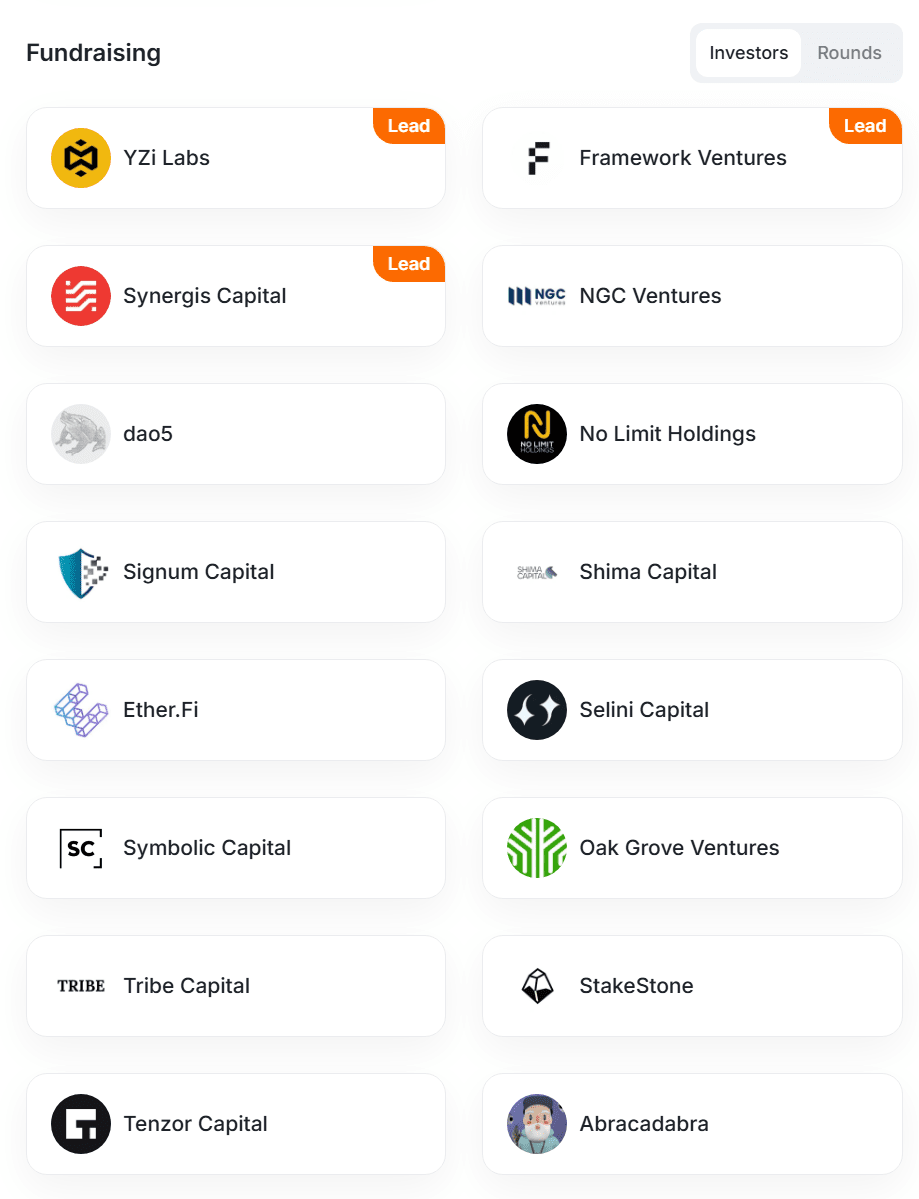
💠 In conclusion
Infrared has innovated more liquidity products based on the Berachain ecosystem. Among them:
POL-vault + $iBGT is the first liquidity product in the network, whose advantage is that users can flexibly participate in LP mining and delegating verification in stages. The returns from POL-vault are mainly in $iBGT, while the returns from staking $iBGT are mainly in $wBERA + $HONEY.
iBERA is a liquidity product similar to Lido, with the advantage of automatic compounding. After staking $BERA once, holding $iBERA is sufficient. The revenue of iBERA is reflected in the premium of $iBERA/$BERA.
$iVault is a high-level liquidity product, and its first product is BYUSD (BYUSD-HONEY trading pair LP) mining. Its advantage lies in the low risk of stablecoin-stablecoin trading pairs. The returns from BYUSD are mainly in $BYUSD + $iBGT + $wBYUSD.
All profitable products can earn points, which can be redeemed for airdrops in the future. Additionally, there are several developer-oriented products, and more designs to balance the price of $iBGT/$BGT are being updated.
The uniqueness of Infrared lies in its innovative liquidity products, which are different from existing LSD products; it is also rare for a liquidity protocol to monopolize the ecosystem like Infrared.
Infrared's innovative capabilities, relationship with Berachain, and financing background may indicate greater potential for Infrared, even the possibility of stepping out of the Berachain ecosystem.

